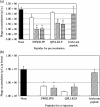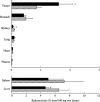Identification of oligopeptides binding to peritoneal tumors of gastric cancer
- PMID: 16984380
- PMCID: PMC11158424
- DOI: 10.1111/j.1349-7006.2006.00291.x
Identification of oligopeptides binding to peritoneal tumors of gastric cancer
Abstract
This is a report of in vivo intraperitoneal biopanning, and we successfully identified a novel peptide to target the multiple peritoneal tumors of gastric cancer. A phage display library was injected directly into the abdominal cavity of mice bearing peritoneal tumors of human gastric cancer, and phages associated with the tumors were subsequently reclaimed from isolated samples. The tumor-associated phages were amplified and the biopanning cycle was repeated five times to enrich for high affinity tumor-selective binding peptides. Finally, a tri-peptide motif, KLP, which showed homology with laminin 5 (a ligand for alpha3beta1 integrin), was identified as a binding peptide for peritoneal tumors of gastric cancer. Phage clones displaying the sequence KLP showed 64-fold higher binding to peritoneal tumors than control phage and were preferentially distributed in tumors rather than in normal organs after intraperitoneal injection into mice. In addition, the KLP phages were more likely to bind to cancer cells in malignant ascites derived from a patient with recurrent gastric cancer. Synthesized peptide containing the motif KLP (SWKLPPS) also showed a strong binding activity to peritoneal tumors without cancer growth effect. Liposomes conjugated with SWKLPPS peptide appeared significantly more often in tumors than control liposomes after intraperitoneal injection into mice. Furthermore, modification of liposomes with SWKLPPS peptide enhanced the antitumor activity of adriamycin on gastric cancer cells. The peptide motif KLP seems a potential targeting ligand for the treatment of peritoneal metastasis of gastric cancer.
Figures







References
-
- Parkin DM, Bray F, Ferlay J, Pisani P. Global cancer statistics, 2002. CA Cancer J Clin 2005; 55: 74–108. - PubMed
-
- Kodera Y, Nakanishi H, Yamamura Y et al. Prognostic value and clinical implications of disseminated cancer cells in the peritoneal cavity detected by reverse transcriptase‐polymerase chain reaction and cytology. Int J Cancer 1998; 79: 429–33. - PubMed
-
- Sadeghi B, Arvieux C, Glehen O et al. Peritoneal carcinomatosis from non‐gynecologic malignancies: results of the EVOCAPE 1 multicentric prospective study. Cancer 2000; 88: 358–63. - PubMed
Publication types
MeSH terms
Substances
LinkOut - more resources
Full Text Sources
Other Literature Sources
Medical

